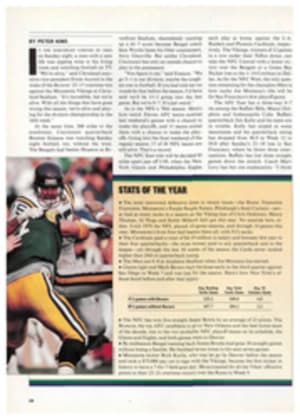
SCORECARD
SEISMIC ACTIVITY
These are times of upheaval in college sports, and not just at Toledo, where athletic director Al Bohl set off shock waves on Nov. 22 by firing football coach Dan Simrell for no apparent good reason (page 32). Last week bigger college programs also felt tremors:
•Bo Schembechler, the fifth-winningest Division I football coach ever (234-64-8), stunned Michigan's devoted legions by announcing his retirement after 21 seasons at the helm of the Wolverines. Still cantankerous after one heart attack and two heart-by-pass operations, Schembechler, 60, this year guided Michigan to a 10-1 regular-season record and his 13th Big Ten title. The Wolverines' Rose Bowl matchup with USC on Jan. 1 will be Schembechler's last game, after which assistant Gary Moeller will take over.
•Schembechler's conference, the Big Ten, will soon be the Big 11—and No. 11 is a biggie. Two weeks ago the presidents of the Big Ten schools met in Chicago and voted to offer an invitation to Penn State, which had been quietly talking with the Big Ten for a decade about possible membership in the conference. Some Big Ten athletic directors were miffed that they weren't consulted. "This confirms the worst fear I have of presidents getting too much control in athletics," said Schembechler, who remains Michigan's athletic director. "Making decisions like this without ever studying it is terrible. Not one athletic director was consulted on this matter. How can they do that?"
Still, the Big Ten should benefit. Penn State shares the conference's solid academic philosophy, and the school's reputation for integrity and athletic prowess will further enhance the Big Ten's stature. Also, adding the Nittany Lions will help the conference land more lucrative TV contracts.
Joining the Big Ten will probably give Penn State a seat on one of the nation's most prestigious academic consortiums, the Committee on Institutional Cooperation, which is composed of the chief academic officers from each of the Big Ten schools and the University of Chicago. It will also bolster the Nittany Lions' athletic income. Penn State makes money from only one sport, football, which pays for the school's 27 other intercollegiate athletic programs. As a Big Ten member, Penn State will get a share of the conference's basketball revenue, perhaps close to $1 million a year.
Although the Nittany Lions will no longer be able to keep all of their bowl money—they will pocket $1 million for playing BYU in the Holiday Bowl on Dec. 29—they will be allowed to retain much of it, and on top of that will get a share of the bowl revenues taken in by other conference schools. This season four Big Ten teams (Michigan, Michigan State, Illinois and Ohio State) are playing in bowl games that will pay them a total of about $8 million; roughly $4.8 million of this will be shared among all 10 conference teams.
Nittany Lion football coach Joe Paterno was rhapsodic about the development, saying it was "a great thing for the prestige of this institution just to be identified with those people." He even hinted that he might postpone retirement in order to coach the Nittany Lions in the Big Ten. But with both Penn State and the Big Ten schools locked into football schedules for at least the next few years, the Big 11, or whatever it will be called, may not get rolling until well into the 1990s.
By then the conference may have transformed itself into the Big 12. As Minnesota athletic director Rick Bay points out, "Eleven is an awkward number to work with." A highly placed source in the Big Ten told SI that Pitt has been mentioned by the presidents as a possible 12th member. If a 12th school is added, the source said, conference teams may well play 11 regular-season football games against Big Ten opponents—and no nonconference games.
•Pitt doesn't have Penn State's reputation for integrity, but last week it took steps that may help remedy that—and might make the Panthers more palatable to the Big Ten—by firing football coach Mike Gottfried and instituting rigorous academic requirements for incoming athletes. Gottfried's academic record is spotty. In 1984 and '85, his last two seasons as coach at Kansas, 18 of his players were ruled academically ineligible. Of the 18 players in his first recruiting class at Pitt the next year, six fell short of Proposition 48 guidelines, which require a 2.0 high school grade point average and a 700 SAT total. Last spring Gottfried clashed with the dean of Pitt's college of arts and sciences over the academic suspension of quarterback Darnell Dickerson—a tiff that didn't go unnoticed by Pitt president Wesley Posvar.
During the summer Pitt was further embarrassed when it became public that four 1989 Panther football recruits and five basketball recruits were Prop 48 cases. Shortly before Gottfried's firing, Posvar approved new academic guidelines that require any athletic recruit who does not carry at least a 2.3 high school GPA and a 750 SAT score to be approved by a review committee.
Gottfried reportedly was axed because he disagreed with school administrators over academic and financial matters and, with a 26-17-2 record in four seasons at the school, failed to return Pitt to the prominence it enjoyed in the late 1970s and early '80s. None of his teams finished in the Top 10, and this year's Panthers, who went 7-3-1 and earned a berth against Texas A&M in the John Hancock Bowl on Dec. 30, beat only one team with a winning record, Syracuse.
•One school that will not be joining the Big Ten is Kentucky, an SEC member whose high-minded president, David Roselle, resigned last week, in part because of his school's basketball scandal. Earlier this year Roselle forthrightly cooperated with an NCAA investigation of the Wildcats' celebrated basketball program, and Kentucky fans and even the state's governor, Wallace Wilkinson, seemed to hold a grudge against him for not giving the NCAA more flak. In May the Wildcats were hit with three years' probation for recruiting and other violations, and Roselle has encountered lingering resentment ever since. In leaving to take the presidency of the University of Delaware, Roselle delivered a sad commentary on basketball mania in the Bluegrass State: "The agenda for the University of Kentucky is education, and I had a difficult problem, which was basketball."
ACT NOW!
A group of New York City entrepreneurs is planning to stage a fantasy camp in what strikes us as an unlikely sport—boxing. For a modest fee of $2,000, campers will be able to spend four days in Atlantic City or Tahoe (the site has not been selected) next April learning the art of fisticuffs. The highlight, so to speak, of each camper's stay will be a round in the ring with one of the instructors, a group that may include former heavyweight champions Joe Frazier, Larry Holmes and Ken Norton.
Don't worry. The $2,000 will include full hospitalization coverage.
GOODBYE TO A PIONEER
Baseball and one of its pioneers parted ways last week. Pam Postema, 35, who had hoped to become the major leagues' first woman umpire (SI, July 30, 1984, et seq.), was released after seven years of umping in Triple A. "Generally, if you get to six years [in the minors] and you haven't been identified as a major league prospect, you're let go," said Ed Lawrence, executive director of baseball's umpire development program. "She was a more-than-adequate Triple A umpire. It's just a numbers game."
Of the four women to have umpired in professional baseball, Postema is the only one to have advanced to the Triple A level. She spent 12 years working the minors, withstanding abuse from fans, players and managers because of her gender. Her only shots at the bigs came in 1988 and '89, when she worked some National League spring training games. "I still think I can do the job as well as anybody," Postema said after her release. "I'm bitter right now, and I don't want to brag, but if I couldn't make it, I don't see how any woman can."
Said Theresa Cox, 29, who worked the Arizona rookie league last season and is baseball's only remaining female ump, "I was pulling for Pam, but I guess that won't be. But if and when I make it [to the majors], I'll know it's been easier because of her."
PHOTO
BRIAN MASCK/ALLSPORT USA
Bo wanted a voice in the Big Ten's expansion.
PHOTO
BILL LUSTER
Roselle (left) quit in frustration; Gottfried was sacked.
PHOTO
G. GOJKOVICH/ALLSPORT USA
[See caption above.]
ILLUSTRATION
PATRICK MCDONNELL
THEY SAID IT
•Candy Davis, wife of relief pitcher Mark Davis, marveling at her husband's new four-year, $13 million contract with the Kansas City Royals: "You'd think he discovered the cure for cancer or something."
•Lou Henson, Illinois basketball coach, on why he is not recruiting Indiana coach Bob Knight's promising 6'6" son Pat: "I didn't want to pay him a home visit."

